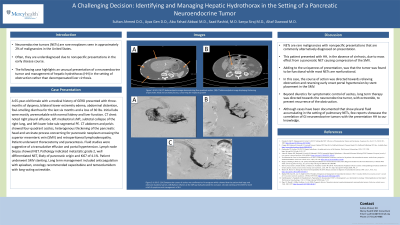Sunday Poster Session
Category: Biliary/Pancreas
P0153 - A Challenging Decision: Identifying and Managing Hepatic Hydrothorax in the Setting of a Pancreatic Neuroendocrine Tumor
Sunday, October 27, 2024
3:30 PM - 7:00 PM ET
Location: Exhibit Hall E

Has Audio
- SA
Sultan Ahmed, DO
Mercy Health
Rockford, IL
Presenting Author(s)
Sultan Ahmed, DO, Ayaz Gen, DO, Abu Abbasi, MD, Saad Rashid, MD, Sanya Siraj, MD, Altaf Dawood, MD, MBBS
Mercy Health, Rockford, IL
Introduction: Neuroendocrine tumors (NETs) are rare neoplasms seen in approximately 2% of malignancies in the United States. These are often underdiagnosed due to nonspecific presentations early in the disease course. The following case highlights an unusual presentation of a neuroendocrine tumor and management of hepatic hydrothorax in the setting of obstruction, rather than decompensated liver cirrhosis.
Case Description/Methods: A 65-year-old female with a past medical history of Gastroesophageal Reflux Disease presented with three months of fatigue, dyspnea, bilateral lower extremity edema, abdominal distention, foul-smelling diarrhea for the last six months, and weight loss of thirty pounds. Computed Tomography (CT) imaging of the chest noted right-sided pleural effusion, left mediastinal shift, subtotal collapse of the right lung, and left lower lobe subsegmental pulmonary embolism. CT showed four-quadrant ascites, heterogenous thickening of the pancreatic head and uncinate process concerning for pancreatic neoplasm encasing the superior mesenteric vein (SMV) and retroperitoneal lymphadenopathy. The patient underwent thoracostomy and paracentesis. Fluid studies were suggestive of a transudative effusion and portal hypertension (HTN). Lymph node biopsy showed NET. The patient underwent SMV stenting. Long-term treatment involved anticoagulation with apixaban, octreotide for diarrhea, and systemic therapy towards the NET with capecitabine and temozolomide per Oncology recommendation.
Discussion: NETs are rare malignancies with nonspecific presentations that are commonly misdiagnosed on presentation. This patient presented with HH in the absence of cirrhosis, due to mass effect from a pancreatic NET causing compression of the SMV. Unlike most NETs, which are nonfunctional, this case demonstrates a functional NET contributing to vasomotor symptoms and diarrhea. In this case, management was directed towards relieving obstruction and portal HTN by stent placement in the SMV. Therapy included diuretics for control of ascites and octreotide to prevent recurrence of the obstruction. Although cases have been documented that show pleural fluid accumulation in the setting of pulmonary NETs, few reports showcase the correlation of GI NETs with the presentation of hepatic hydrothorax to our knowledge. Overall, this case underscores the necessity for a comprehensive and multidisciplinary approach to the diagnosis and management of NETs, particularly in the setting of rare and challenging presentations like HH.
Disclosures:
Sultan Ahmed, DO, Ayaz Gen, DO, Abu Abbasi, MD, Saad Rashid, MD, Sanya Siraj, MD, Altaf Dawood, MD, MBBS. P0153 - A Challenging Decision: Identifying and Managing Hepatic Hydrothorax in the Setting of a Pancreatic Neuroendocrine Tumor, ACG 2024 Annual Scientific Meeting Abstracts. Philadelphia, PA: American College of Gastroenterology.
Mercy Health, Rockford, IL
Introduction: Neuroendocrine tumors (NETs) are rare neoplasms seen in approximately 2% of malignancies in the United States. These are often underdiagnosed due to nonspecific presentations early in the disease course. The following case highlights an unusual presentation of a neuroendocrine tumor and management of hepatic hydrothorax in the setting of obstruction, rather than decompensated liver cirrhosis.
Case Description/Methods: A 65-year-old female with a past medical history of Gastroesophageal Reflux Disease presented with three months of fatigue, dyspnea, bilateral lower extremity edema, abdominal distention, foul-smelling diarrhea for the last six months, and weight loss of thirty pounds. Computed Tomography (CT) imaging of the chest noted right-sided pleural effusion, left mediastinal shift, subtotal collapse of the right lung, and left lower lobe subsegmental pulmonary embolism. CT showed four-quadrant ascites, heterogenous thickening of the pancreatic head and uncinate process concerning for pancreatic neoplasm encasing the superior mesenteric vein (SMV) and retroperitoneal lymphadenopathy. The patient underwent thoracostomy and paracentesis. Fluid studies were suggestive of a transudative effusion and portal hypertension (HTN). Lymph node biopsy showed NET. The patient underwent SMV stenting. Long-term treatment involved anticoagulation with apixaban, octreotide for diarrhea, and systemic therapy towards the NET with capecitabine and temozolomide per Oncology recommendation.
Discussion: NETs are rare malignancies with nonspecific presentations that are commonly misdiagnosed on presentation. This patient presented with HH in the absence of cirrhosis, due to mass effect from a pancreatic NET causing compression of the SMV. Unlike most NETs, which are nonfunctional, this case demonstrates a functional NET contributing to vasomotor symptoms and diarrhea. In this case, management was directed towards relieving obstruction and portal HTN by stent placement in the SMV. Therapy included diuretics for control of ascites and octreotide to prevent recurrence of the obstruction. Although cases have been documented that show pleural fluid accumulation in the setting of pulmonary NETs, few reports showcase the correlation of GI NETs with the presentation of hepatic hydrothorax to our knowledge. Overall, this case underscores the necessity for a comprehensive and multidisciplinary approach to the diagnosis and management of NETs, particularly in the setting of rare and challenging presentations like HH.
Disclosures:
Sultan Ahmed indicated no relevant financial relationships.
Ayaz Gen indicated no relevant financial relationships.
Abu Abbasi indicated no relevant financial relationships.
Saad Rashid indicated no relevant financial relationships.
Sanya Siraj indicated no relevant financial relationships.
Altaf Dawood indicated no relevant financial relationships.
Sultan Ahmed, DO, Ayaz Gen, DO, Abu Abbasi, MD, Saad Rashid, MD, Sanya Siraj, MD, Altaf Dawood, MD, MBBS. P0153 - A Challenging Decision: Identifying and Managing Hepatic Hydrothorax in the Setting of a Pancreatic Neuroendocrine Tumor, ACG 2024 Annual Scientific Meeting Abstracts. Philadelphia, PA: American College of Gastroenterology.

